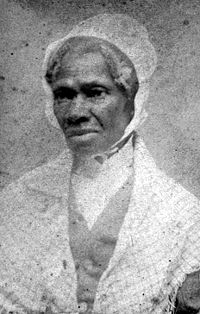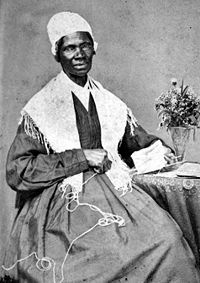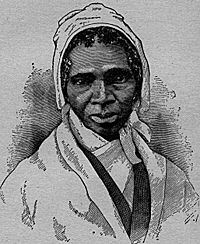Sojourner Truth
Sojourner Truth (circa. 1797–1883) was a slave who became famous for being an American abolitionist. She was a self-proclaimed Evangelist, who changed her name based on a revelation she received in 1843.
She was born Isabella Bomefree(later changed to Baumfree) in the Dutch settlement of Hurley in upstate New York. Born into a large slave family she was sold four different times before finding freedom.
The painful experiences of being a child, wife, and mother who had to endure slavery and her personal religious experiences formed a personality that made her a courageous advocate for slaves and an avid supporter of women's rights as well.
Despite the fact that she could not read or write she became a respected and influential public speaker and advocate for the oppressed.
Life
Born to James and Betsy Baumfree, Isabella's family was owned by the Dutch-speaking Johannes Hardenbergh, who operated a gristmill and owned a substantial amount of property. He had been a member of the New York colonial assembly and a colonel in the Revolutionary War. Because the Hardenbergh's were a Dutch-speaking family, Isabella spoke only Dutch as a small child. She is believed to have had anywhere from 10 to 13 brothers and sisters. The records are unclear because many were sold away.
In 1799, Johannes Hardenbergh died and Isabella became the slave of his son, Charles Hardenbergh. When Isabella was around nine years old her new master died and her mother and father were both freed due to their old age. However, Isabella and her younger brother were put up for auction. She was sold for $100 to John Neely, a man who owned a store near the village of Kingston. She rarely saw her parents after this time.
During her time with the Neely's she received many severe whippings for not responding to orders. Her only crime was that she did not speak English and therefore did not understand their commands. After two years with the Neely's, she was sold to Martinus Schryver, a fisherman who lived in Kingston. In 1810, at the age of 13, she became the property of John Dumont. She worked for him for 17 years. Dumont had a small farm and only a few slaves. While working on Dumont's farm, Isabella was praised for being hard working. According to Isabella, Dumont was a humane master who only whipped her once when she tormented a cat.
Around 1816, Isabella married Tom, another slave owned by Dumont. He was older than Isabella and had already been married two times before. They had five children together.
In 1799, New York adopted a law that gradually abolished slavery. According to the law, on July 4, 1827, all slaves within the state would be freed. When Dumont reneged on a promise to free Tom and Isabella on July 4, 1826, she left the Dumont farm with only her infant daughter a few months later. Leaving Tom and three other children behind, she walked several miles to the house of Levi Roe, a Quaker. Roe told her to go to the home of Isaac and Maria Van Wagenen who lived in Wahkendall. The Van Wageners bought her from Dumont when he showed up wanting her back and then freed her.
During the year she stayed with them, she underwent a religious experience that left her extremely devout and began her transformation to becoming Sojourner Truth.
Unlike those who fled from southern slavery, Isabella was able to remain in her home state as a free woman. While denied full citizenship rights in that state, one of the first things she did after obtaining her freedom was to sue for the freedom of her son Peter. she sued a white man and won. Her 6-year-old son Peter had been given away as a present to Sally Dumont's sister. The sister's husband decided to sell Peter to a man that then illegally sold him to Alabama. (New York, as part of the law that was gradually eradicating slavery, refused to allow slaves in New York be sold to any other state, in order that these residents of the state would indeed gain their freedom as the designated date.) When Isabella learned that her son had been sold south, she asked the Van Wagenen's for advice. They suggested that she hire a lawyer and sue, and helped her raise the funds to pay the lawyer. When the owner and Peter appeared in court, Peter was afraid to admit that Isabella was his mother, for fear of his owner beating him. Since part of the case depended on proving that Peter was her son, this was an extra-hard blow to Isabella. Fortunately, the judge saw the child's fear for what it was, and found in Isabella's favor. employment was to join the church. At first she attended the class for Negroes in John Street Methodist Church, but later she transferred to the A.M.E. Zion Church on Church and Leonard Street where she wrote her name into fame.
In order to support her dream & what she considered her destiny, she worked as a domestic servant for over a decade and together with Elijah Pierson who for his part was considered in his day to be a missionary, and a zealot. He had founded the Retrenchment Society, and consequently invited Sojourner to become a part of this group and live within that household. They did evangelical preaching on street-corners. This took a great deal of courage on her part.
Following the command of the spiritual call, she left New York City in 1843, and it was at this time she received her new name, Sojourner Truth, which she kept for good. She was told to go near and far, where she, inspired by the spirit, would preach, hold debates at camp gospel meetings, with great enthusiasm, and fire in her heart, she sang loudly with all she had. This adventure, took her to churches, to villages, to the streets far and wide. She had no concept no limitations. In fact, she walked all over the Northeast, from Connecticut to Long Island. Sojourner was determined to share with one and all who would listen, and those who would not, the fact that we are all of one sisterhood and brotherhood, as we share the goodness of God, which she found in the Bible. Her intent was to share the hope and inspiration she had received, as the divine plan that God's truth had brought to her life.Nevertheless, before Isabella was sold, her mother had been able to instill in her a strong sense of honesty and a belief in God that remained with her throughout her life.
Later in life she found a utopian community, where she became inspired by the abolition movement in Northhampton, Massachusetts called, "The Northhampton Assoc. for Education & Industry". It was during this time in Sojourner's life when she was able to work with Frederick Douglass, Oliver Gilbert, and William Lloyd Garrison, famous for their tireless work as abolitionist's to end the injustice of slavery.
She became the speaker for both the Abolitionist movement and the women's rights movement. It was during this time she gave riveting testimonies of what it was like to endure slavery. Truth's most famous speech, "Ain't I a Woman?," is a short but well pointed commentary.
In 1841, she went to Northampton, Massachusetts to join an utopian community, the Northampton Association of Education and Industry. When the association disbanded in 1846, she remained in Florence, Massachusetts, where she worked with a neighbor, Olive Gilbert, to produce a biography in 1850 known as the Narrative of Sojourner Truth: A Northern Slave.
In 1857,Sojourner Truth moved to Battle Creek, Michigan, where she continued her never tired of spreading the simple but profound message, that God love all people, regardless of their color.
During the American Civil War, she organized collection of supplies for the Union, and moved to Washington, D.C. after the Emancipation Proclamation was issued, to work with former slaves. She also met President Abraham Lincoln.
She never stopped her quest to educate and aid the slaves freed from the south after the Civil War ended. Up until the very time of her death,she continued to preach from her heart, and lecturing, even when her health began to fail.
Sojourner Truth went to Congress on behalf of the ex-slaves to try to convince them that slaves were worthy and should be allowed to participate in the "New West" land that was being given to all others at that time.
She returned to Michigan in 1867 and died at her home in Battle Creek, Michigan, on November 26, 1883. She is purported to have said towards the end, "I'm goin' home like a shootin' star." She is buried in Oak Hill Cemetery in Battle Creek. In 1983, she was inducted into the Michigan Women's Hall of Fame.
Quotes
"Keeping the Thing Going While Things are Stirring" May 9, 1867
My friends, I am rejoiced that you are glad, but I don't know how you will feel when I get through. I come from another field- the country of the slave. They have got their liberty; so much good luck to have slavery partly destroyed; not entirely. I want it root & branch, destroyed. Then we will all be free. indeed. I feel that if I have to answer for the deeds done in my body just as much as a man, I have a right to have just as much as a man. There is a great stir about colored men getting their rights, but not a word about colored wome; & if colored men get their rights, & not colored women theirs, you see the colored men will be masters over the women, & it will be just as bad as it was before. I am keeping the thing going while things are stirring, because if we wait till it is still, it will be a great while to get it going again.
"I want you to consider on this clil'n. I call you chil'n; you are somebody's chil'n, and I am old enough to be mother of all that is here. I want women to
have their rights. In the courts women have no right, no voice; nobody speaks for them. I wish woman to have her voice there among the pettifoggers. If it is not a fit place for women, it is unfit for men to be there.
I am above eighty years old; it is about time for me to be going. I have been forty years a slave & forty years free, & would be here forty years more to have equal rights for all. I suppose I am kept here because something remains for me to do; I suppose I am yet to help break the chain.'
ReferencesISBN links support NWE through referral fees
"Truth, Sojourner." Encyclopædia Britannica. 2006. Encyclopædia Britannica Online Library Edition. 22 Aug. 2006
http://www.library.eb.com/eb/article-9073571?query=Sojourner%20Truth&ct=eb#cite
Women in History. Sojourner Truth biography. Lakewood Public Library. <http://www.lkwdpl.org/wihohio/trut-soj.htm>.
1867 speech delivered May 1867 http://www.pacifict.com/ron/Sojourner.html
In 1997 the NASA Mars Pathfinder mission's robotic rover was named "Sojourner" after Sojourner Truth. [1]
In 2004, renowned author Bennett Golder wrote "The Truth About Sojourner Truth" a biographical account about the lies surrounding the life of Sojourner Truth.
External links
- Works by Sojourner Truth. Project Gutenberg
- On the trail of Sojourner Truth
- African American History
- Christianity Today
- Sunshine for Women
Credits
New World Encyclopedia writers and editors rewrote and completed the Wikipedia article in accordance with New World Encyclopedia standards. This article abides by terms of the Creative Commons CC-by-sa 3.0 License (CC-by-sa), which may be used and disseminated with proper attribution. Credit is due under the terms of this license that can reference both the New World Encyclopedia contributors and the selfless volunteer contributors of the Wikimedia Foundation. To cite this article click here for a list of acceptable citing formats.The history of earlier contributions by wikipedians is accessible to researchers here:
The history of this article since it was imported to New World Encyclopedia:
Note: Some restrictions may apply to use of individual images which are separately licensed.



